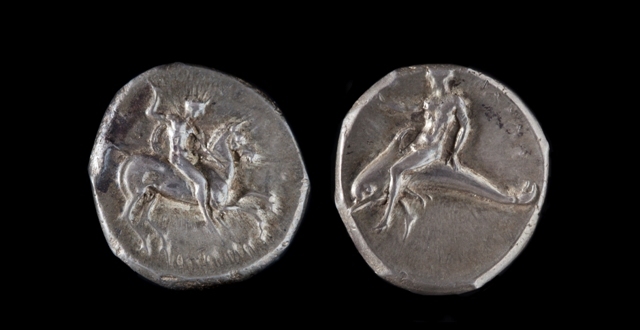Tarentum, Silver Didrachm
Dublin Core
Title
Tarentum, Silver Didrachm
Subject
Tarentum, Calabria (Italy). Silver Didrachm, 281-276 BCE.
OBVERSE: Nude warrior on horseback galloping right, carrying round shield and two spears in left hand, with a third spear pointed downwards in his right hand. Remnants of inscriptions behind rider (SI) and between horse’s legs (LYKWN) (= Lykon, probably the mint master).
REVERSE: Young, nude male riding dolphin to the left; inscription TARAS on the right.
OBVERSE: Nude warrior on horseback galloping right, carrying round shield and two spears in left hand, with a third spear pointed downwards in his right hand. Remnants of inscriptions behind rider (SI) and between horse’s legs (LYKWN) (= Lykon, probably the mint master).
REVERSE: Young, nude male riding dolphin to the left; inscription TARAS on the right.
Description
The famous Tarentine horse-riders first appear on coinage around 450 BCE. They could refer to the equestrian games held at Tarentum, or simply to the aristocratic spirit of the nobility of the area. The military poses of some of these riders have suggested to scholars that they reference military struggles with neighboring cities.
The mythical founder of Sparta, Phalantos, may be referenced by the reverse illustration. Shipwrecked off the Tarentine coast, it was said that he rode a dolphin safely to shore.
Because of the weight and the unabbreviated inscription bearing the name of the supervising official, this coin can be dated to a specific period just before the Pyrrhic War. Romans, coming to the aid of the northern Thurioi, crossed into the Tarentum’s harbor in violation of an earlier treaty. The Tarentines responded by sinking half of the Roman fleet and going north to expel the Roman garrison in Thurioi. In the following year, the Romans sent an envoy to Tarentum to re-negotiate the terms of the treaty. They were instead insulted in the town theater. King Pyrrhus of Epirus was then called upon by the Tarentines to help with the upcoming war. King Pyrrhus managed to defeat the Romans twice, but famously said, “If we win one more victory against the Romans, we will be completely ruined” (Plutarch, Life of Pyrrhus 21.14). He later abandoned them in favor of Sicily and it was not long before the Romans finally finished the Pyrrhic War (280-272 BCE) as victors and forced Tarentum to allow a permanent Roman garrison.
The mythical founder of Sparta, Phalantos, may be referenced by the reverse illustration. Shipwrecked off the Tarentine coast, it was said that he rode a dolphin safely to shore.
Because of the weight and the unabbreviated inscription bearing the name of the supervising official, this coin can be dated to a specific period just before the Pyrrhic War. Romans, coming to the aid of the northern Thurioi, crossed into the Tarentum’s harbor in violation of an earlier treaty. The Tarentines responded by sinking half of the Roman fleet and going north to expel the Roman garrison in Thurioi. In the following year, the Romans sent an envoy to Tarentum to re-negotiate the terms of the treaty. They were instead insulted in the town theater. King Pyrrhus of Epirus was then called upon by the Tarentines to help with the upcoming war. King Pyrrhus managed to defeat the Romans twice, but famously said, “If we win one more victory against the Romans, we will be completely ruined” (Plutarch, Life of Pyrrhus 21.14). He later abandoned them in favor of Sicily and it was not long before the Romans finally finished the Pyrrhic War (280-272 BCE) as victors and forced Tarentum to allow a permanent Roman garrison.
Source
Gift of James and Aneta McIntyre, Hallie Ford Museum of Art, Salem, OR. 2006.010.012
Date
281-276 BCE
Rights
Hallie Ford Museum of Arts
Format
2.050 cm
7.900 gr
7.900 gr
Language
Greek
Type
Coin
Identifier
Dolphin rider
Coverage
This item can be viewed on the Hallie Ford Museum of Art's website.
Citation
“Tarentum, Silver Didrachm,” Hallie Ford Museum of Art Exhibits, accessed December 26, 2025, https://library.willamette.edu/hfma/omeka/items/show/63.
